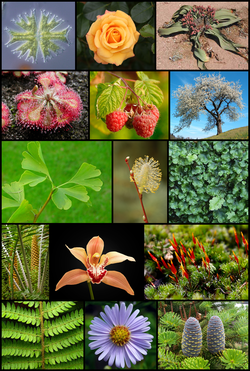Dichotomous Key/Plantae
 Various plants | |
| Kingdom | Plant |
|---|---|
Information related to Plantae Wikipedia • Wikispecies • Wikicommons | |
| Glossary for this page (all links are to Wikipedia articles) | ||||||
|---|---|---|---|---|---|---|
|
Plants are mainly multicellular, predominantly photosynthetic eukaryotes of the kingdom Plantae.
The term is today generally limited to the green plants, which form an unranked clade Viridiplantae (Latin for "green plants"). This includes the flowering plants, conifers and other gymnosperms, ferns, clubmosses, hornworts, liverworts, mosses and the green algae, and excludes the red and brown algae. Historically, plants formed one of two kingdoms covering all living things that were not animals, and both algae and fungi were treated as plants; however all current definitions of "plant" exclude the fungi and some algae, as well as the prokaryotes (the archaea and bacteria).
Green plants have cell walls containing cellulose and obtain most of their energy from sunlight via photosynthesis by primary chloroplasts, derived from endosymbiosis with cyanobacteria. Their chloroplasts contain chlorophyll a and b, which gives them their green color. Some plants are parasitic and have lost the ability to produce normal amounts of chlorophyll or to photosynthesize. Plants are characterized by sexual reproduction and alternation of generations, although asexual reproduction is also common.
There are about 300–315 thousand species of plants, of which the great majority, some 260–290 thousand, are seed plants. Green plants are the basis of most of Earth's ecologies, especially on land. Plants that produce grains, fruits and vegetables form humankind's basic foodstuffs, and have been domesticated for millennia. Plants play many roles in culture. They are used as ornaments and, until recently and in great variety, they have served as the source of most medicines and drugs. The scientific study of plants is known as botany, a branch of biology.
Start
- 1: Green algae; mostly aquatic. Chlorophyta and Charales.
- 2: Not Green algae; aquatic or terrestrial. Streptophyta / Embryophyta.
1
Green algae; mostly aquatic. Chlorophyta and Charales.
2
Not Green algae; aquatic or terrestrial. Streptophyta / Embryophyta.
- 3: Non-vascular land plants. Bryophyta, including liverworts, hornworts, and mosses.
- 4: Vascular plants with tissue for conducting water. Tracheophyta, including clubmosses, horsetails, ferns, seed and flower producing plants.
3
Non-vascular land plants. Bryophyta.
4
Vascular plants. Tracheophyta.
- 5: Spore producing plant. Clubmosses, spikemosses, horsetails, and ferns.
- 6: Seed producing and flowering plants. Gymnosperms and angiosperms.
5
Spore producing plant.
- 10: Leaves thin, needle-like. Clubmoss, spikemoss, or horsetail
- Fern: Leaves thin to broad, often branching pinnately or multi-pinnately. Fern.
6
Seed producing and flowering plants.
- Cycad: Trunk is cylindrical and does not branch; leaves grow directly from trunk, usually clustered near the top. Cycad.
- 7: Trunk absent or branches extend from trunk; Leaves generally grow on branches rather than directly from trunk.
7
Trunk absent or branches extend from trunk.
8
Flowering plant. Angiosperm.
9
Non-flowering plant. Gnetophyte.
- Ginkgo biloba: Leaves have dichotomous venation (veins continuously divide into 2).
- Conifer: Leaves do not have dichotomous venation.
10
Leaves thin, needle-like.
- Horsetail: Leaves (if present) needle-like, arranged into whorls at equal spacing along stem. Horsetail.
- 11: Leaves not needle-like or no spacing / unequal spacing between leaves on stem.